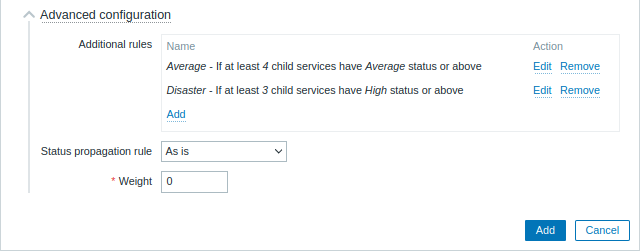1 Service tree
服务树的有关配置位于Services -> Services 菜单配置部分。用户可以通过位于右上角的 View 按钮进入到编辑模式。

用户若需要 配置 一个新的服务,可以点击位于界面右上角的Create service 按钮。
用户若需要快速添加一个子服务,也可以点击父服务旁边的加号图标。这将打开相同的服务配置表单,但将预先填写 Parent services (父服务) 参数。
服务配置
在Service 配置选项中, 明确需要的服务参数:

所有的必要字段均标有红色星号。
| 参数 | 说明 |
|---|---|
| Name | 服务名称 |
| Parent services | 当前服务所属的父服务。 若用户创建的为最高等级的服务,请将此字段留白。 一个服务可以有多个父服务。这种情况下,子服务会显示在每个父服务的服务树中。 |
| Problem tags | 指定映射到服务的问题数据标签: Equals - 包含该标签的标签名称和值(区分大小写) Contains - 包含该标签的标签名,其中标签值包含输入的字符串(子字符串的匹配不区分大小写) 标签名称的匹配始终需要区分大小写。 |
| Sort order | 排序显示,最低等级的排在第一位。 |
| Status calculation rule | 计算服务状态的规则: Most critical if all children have problems - 如果所有子服务均存在问题,则根据子服务中最严重的问题对其服务状态进行着色标注。 Most critical of child services - 根据子服务中最严重的问题对其服务状态进行着色标注。 Set status to OK - 不对服务状态进行计算 附加状态计算规则可以在高级配置 完成配置。 |
| Description | 服务描述。 |
| Created at | 显示创建该服务的时间;当编辑一个已存在的服务时会显示该参数。 |
| Advanced configuration | 勾选高级配置 标签来展示高级配置 选项。 |
高级配置

| 参数 | 说明 |
|---|---|
| Additional rules | 点击添加 来配置附加的状态计算规则。 |
| Set status to | 用户可以根据不同条件将服务状态配置为OK (缺省配置), Not classified, Information, Warning, Average, High 或者Disaster。 |
| Condition | 对于子服务条件的选择遵循: 如果有至少(N)个或(N)个以上子服务具有(Status)状态 如果至少(N%)或(N%)以上的子服务具有(Status)状态 如果有少于(N)个或(N)个以下的子服务具有(Status)状态 如果有小于(N%)的子服务具有(Status)状态 如果具有(Status)状态的子服务拥有至少或大于(W)的权重 如果具有(Status)状态的子服务拥有至少或大于(N%)的占比 如果拥有(Status)状态的子服务权重小于(W) 如果具有 (Status)状态的子服务的权重小于(N%) 如果指定了多个条件,并且实际情况与指定的条件匹配,则将该子服务认定为具备最高的严重性 |
| N (W) | 在条件配置中,设定N或W (1-100000),或者N% (1-100)的值。 |
| Status | 选择与条件有关的Status(状态): OK (default), Not classified, Information, Warning, Average, High 或者 Disaster。 |
| Status propagation rule | 将服务状态传播至父服务的规则设定: As is - 传播的状态没有发生变化 Increase by - 用户可以将传播的状态增加值1到5个严重性 Decrease by - 用户可以将传播的状态减少1到5个严重性 Ignore this service - 该状态不会传播至父服务。 Fixed status - 状态以静态的形式传播即始终不会发生改变。 |
| Weight | 服务的权重(0 (缺省值)到1000000之间的整数)。 |
附加的状态计算规则只能用于将严重级别提升到根据Status calculation rule(状态计算规则)所计算的级别之上。如果根据附件规则所计算出来的状态设定为Warning级别,但根据Status calculation rule(状态计算规则)计算出来的状态为Disaster - 则该服务的状态为Disaster。
Tags标签包含服务级别标签。服务级别标签用于标识服务级别。这种类型的标签不用于将问题映射到服务(因此,使用问题标签中的第一个标签)。
Child services标签允许指定依赖的子服务。点击添加从现有服务列表中添加新的服务。如果用户要添加新的子服务,请先保存原有服务,然后点击刚刚创建的服务旁边的加号按钮。
标签
在服务中存在两种不同种类的标签:
- 服务标签
- 问题标签
服务标签
服务标签用于将服务与 服务动作 和 SLAs相匹配。这些标签在Tags(标签)服务选项标签中进行配置。对于SLAs映射, 使用OR(或):如果服务至少有一个匹配的标签,则将其映射到SLA。在服务动作中,映射规则是可以进行配置的,用户可以使用AND(与),OR(或),或者 AND/OR 逻辑。

问题标签
问题标签用于配文问题与服务。这些标签可在主服务配置选项中进行制定。
只有最低等级的子服务可以定义问题标签并直接关联问题。如果问题标签匹配成功,服务状态将更改为与问题相同的状态。当处在多个问题的情况下,服务将展示最严重的状态。然后根据状态计算规则基于子服务状态计算父服务的状态。
如果指定了多个标签,则使用AND逻辑:问题必须将服务配置所制定的所有标签都映射到服务。

Zabbix中的问题从模板、主机、监控项、Web场景和触发器的整个关系链中集成标签。这些标签中的任何一个都可用于匹配问题与服务。
示例:
问题Web camera 3 is down(网页摄像头3关闭)拥有标签type:video surveillance, floor:1st 和 name:webcam 3 ,该问题状态为Warning。
服务Web camera 3 拥有指定的唯一标签: name:webcam 3

当监控系统检测到上述问题是,服务状态就从OK 改变为了 Warning。
如果服务Web camera 3有问题标签 name:webcam 3 和 floor:2nd,则在检测到问题是系统不会更改其状态,因为这个问题仅仅满足问题的部分条件。
修改现有服务
以下内容中所描述的按钮仅在服务版本出于编辑模式时可见。
用户要编辑现有的服务,请点击位于服务胖的铅笔图表。
用户要克隆现有服务,请点击铅笔图表打开其配置界面,然后点击克隆按钮。克隆服务时,系统会保留期父链接,而不会保留子链接。
用户要删除服务,请点击服务旁边的 x 图表。删除父服务时,其子服务不会被删除,并且会将其在服务架构中的级别向上移动一级(第一级别的子服务将获得与删除的父服务相同的级别)。
服务列表下方的两个按钮提供了一些批量编辑的可选项:
- Mass update - 批量更新服务属性
- Delete - 删除服务
若用户要使用这些选项,请在相对应的服务前侧勾选复选框,然后点击所需要的应用按钮。

